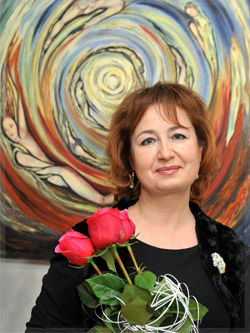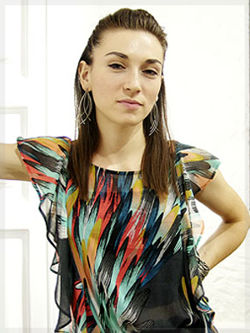


What is Modern Pictorial Art?

Modern art generally refers to works that were produced between 1860 and 1970 (roughly) that incorporate the use of experimentation in technique, or subject matter. Artists prior to this time period had specific techniques that were en vogue and straying outside the limits of what was considered acceptable was somewhat risky. But, with the dawn of the industrial revolution, artists suddenly became sensitive to new possibilities as far as what was worthy of being portrayed artistically and how the subject matter could be communicated to an audience. The experimentation that followed the beginning of modern art has helped to set the stage for even more innovative contemporary artistic strategies in pictorial art.
Artists who began the spirit of innovation included Vincent van Gogh, Paul Cezanne, Paul, Gaugin, Georges Seurat, and Henri de Toulouse Lautrec. These artists specifically introduced new methods in artistic expression as well as new and experimental subject material. Pablo Picasso, famous for his cubist techniques of portraying a 3 dimensional image from all sides on a 2 dimensional plane, is also associated with the modern pictorial art movement. Picasso followed in the footsteps of Cezanne, creating works based on Cezanne's ideas that all natural objects can be reduced to three solid shapes; cubes, spheres, and cones. Using new methods of exploring Cezanne's ideas, Pablo Picasso came up with an exciting new technique that changed art forever. He experimented with new, risque subject material involving such taboo topics as prostitution.

Pablo Picasso's efforts as a modern pictorial artist has influenced a number of other artists over the years. Cubism has been elaborated upon by other artists, for example. Artists have incorporated different textures into cubist techniques, creating different surfaces to work with in the painting. Collage has been utilized in cubist works by artists influenced by Pablo Picasso.
Modern pictorial artists have influenced and been influenced by other modern pictorial artists, creating a sort of dialogue of experimentation in the artistic world. New artistic inventions served to inspire budding artists to take their experimentation efforts even further. Utilizing the vast variety of media and techniques that have become available, modern pictorial art has been able to express and communicate about facets of the human condition that were once entirely ignored.
Van Gogh explored the limits of impressionism or how to communicate an impression to observers without providing exact details. Pablo Picasso used 2 dimensional media to create 3 dimensional impressions of people, objects and situations. Jackson Pollock used paint dripping and splattering technique to invite the eye to feast on the rhythm of our own humanity. Modern pictorial artists have pioneered new ways of seeing the world and new ways of seeing our inner reality at the same time. Inspired by the changes brought forth by industrialization in the modern world, modern pictorial artists have taken art to a new level. Experimentation in artistic methodologies have made it possible to gain access to the spirit that drives us as humans. Through modern pictorial art, we are able to look at the ugly and the beautiful sides of human nature and see it for what it is, without judgment.
Modern Pictorial Art Techniques

The advent of modern art began roughly with the industrial revolution. Some art scholars officially date its beginning in the 1860's. The popularity of modern art techniques are said to have begun to wane in the 1970's. With the development of machines and factories, significant changes occurred in the way people lived their lives and subsequently in the way artists approached their work. Modern art became less about portraying real life situations and more about portraying feelings, thoughts, and ideas about life. New technologies evolved allowing artists the ability to communicate their impulses using media such as photography, for example.
Modern pictorial artists have a diverse array of media and techniques to choose from as they begin the journey into the inner realms of the human experience. Modern pictorial art techniques are as diverse as the inner landscapes they represent. Modern pictorial artists enjoy the benefits of having the knowledge of other artists, from eras past who have developed and honed techniques that can be further elaborated upon to arrive at messages and ideas that are complex and sophisticated.
Vincent Van Gogh, for example, began a tradition of using paint not just to precisely depict landscapes or situations exactly as they occurred, but also to use paint as a medium to describe visual and emotive impressions made on the artist by the artist's surroundings. Impressionism and other forms of abstraction have played a major role in the modern pictorial art movement over the years.

Modern pictorial artists have some rather diverse methodologies to choose from to express their emotions and ideals. For example, modern pictorial artists have used paint in less traditional ways to produce effects that have a surprisingly high level of emotional content. Splashing paint on a canvas can be particularly expressive. For example, Jackson Pollock used paint splashing and splattering techniques to bring depth and dimension to thoughts that are otherwise challenging and difficult to portray. His techniques were innovative in that the positive and negative spaces in his works were balanced. Neither the positive nor the negative space demanded observer's attention. Additionally, though there was rhythm to his work and definitely a captivating quality that people were able to appreciate and enjoy, his work really contained no visual representation of any particular symbol or object. Rather, some art experts have theorized that part of Jackson Pollock's skill lie in the fact that his work exemplified patterns that could be described in fractals.
Art prior to the modern era was precise and factual. In the modern era, art became much more subjective and experimental. Indeed, whereas a large variety of different techniques had been in use for centuries, modern art is characterized by a willingness to try new things. Modern artists, in contrast to the artists who came before them, worked to see the world from an entirely new perspective, formulating works that not only reflected this fresh way of seeing things but also incorporated new artistic techniques into their work. Modern pictorial art began to push the limits of expression by using media in surprising and unexpected ways.
Modern Pictorial Artists

The development of modern art paralleled major developments in industry. As the average person's way of life changed, it no longer seemed appropriate to use the same methods as what had been in use for hundreds of years to express artistic ideas. Several modern artists lead the way and set the stage for the next generation of experimenters and innovators.
Of particular importance in the modern art movement was Vincent Van Gogh. Van Gogh was a Dutch painter, who was known for his impressionistic works that used bold colors. Van Gogh had a way of conveying unabashed emotional honesty through his artistic creations. He was a tormented man who suffered from chronic and debilitating anxiety problems. He was regularly afflicted with mental health issues. He died at a young age from a self-inflicted gunshot wound. When he died, he and his work were hardly known or appreciated.

Paul Cezanne was another important modern pictorial artist. His work was, like Van Gogh's impressionist. His paintings did not attempt to portray situations as they actually looked, but rather by combining symbolic elements and aspects of a situations' material facade with an emotional overlay superimposed on top. Cezanne's work is considered to be important in laying the groundwork for Pablo Picasso's cubist methodologies. Cezanne was responsible for noting that natural objects are generally composed of one of three basic shapes: cube, sphere, or cone. Recognizing this fact of nature, ultimately lead Pablo Picasso to explore it with greater depth and develop one of the most famous artistic techniques known today.
Pablo Picasso is a well known modern pictorial artist who strove to develop new ways of seeing the world while still capturing the essence of a particular object or situation. Picasso explored Cezanne's ideas about geometric shapes and arrived at an entirely new artistic technique called “cubism”. Cubism utilizes these geometric shapes to convey information about a particular object or subject material, while exploring it in 3 dimensions on a 2 dimensional plane. Cubism is a multi-faceted effort that combines philosophies about how nature works and how the human mind works to piece together information. The simplistic ideals of cubism are surprisingly informative and interesting. Pablo Picasso's efforts as a modern pictorial artist have had a profound effect on art as a whole. He has influenced innumerable artists with his work and his philosophies.

Paul Gaugin was yet another early influential modern pictorial artist who was known for using symbolism in impressionistic paintings. He was not simply known as a pictorial artist. Paul Gaugin was also known as a sculptor, wood cutter and engraver, print-maker, and ceramist. He also spent some time writing. His major influence on art had to do with his use of color, which lead to a whole new artistic movement known as the Synthetist style. Gaugin used bold colors to portray images while expertly manipulating symbols to arrive at innovative new pictorial creations. Gaugin's paintings contain striking colors that depict realistic and symbolic themes in ways that have captivated both artists and observers for years.
We Help Sell Art On web!



